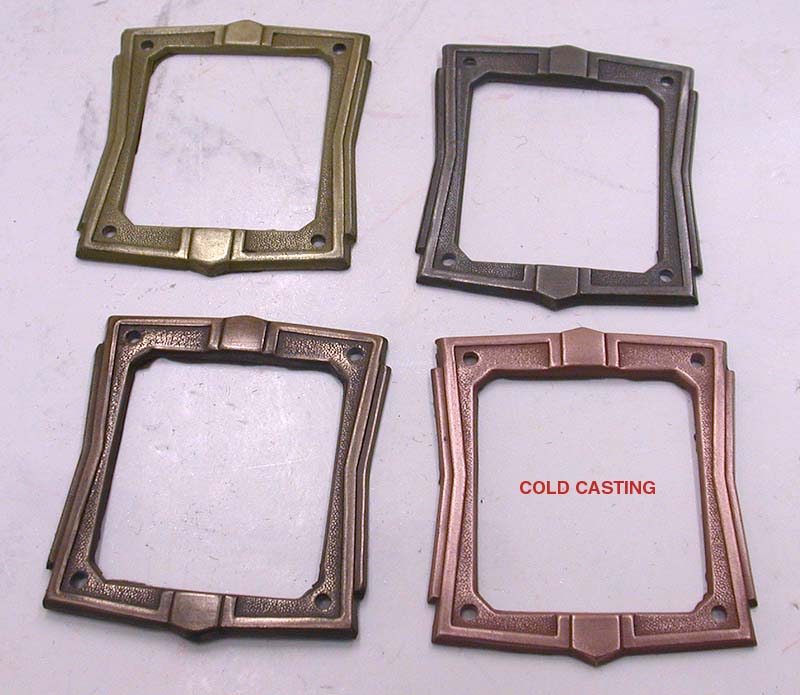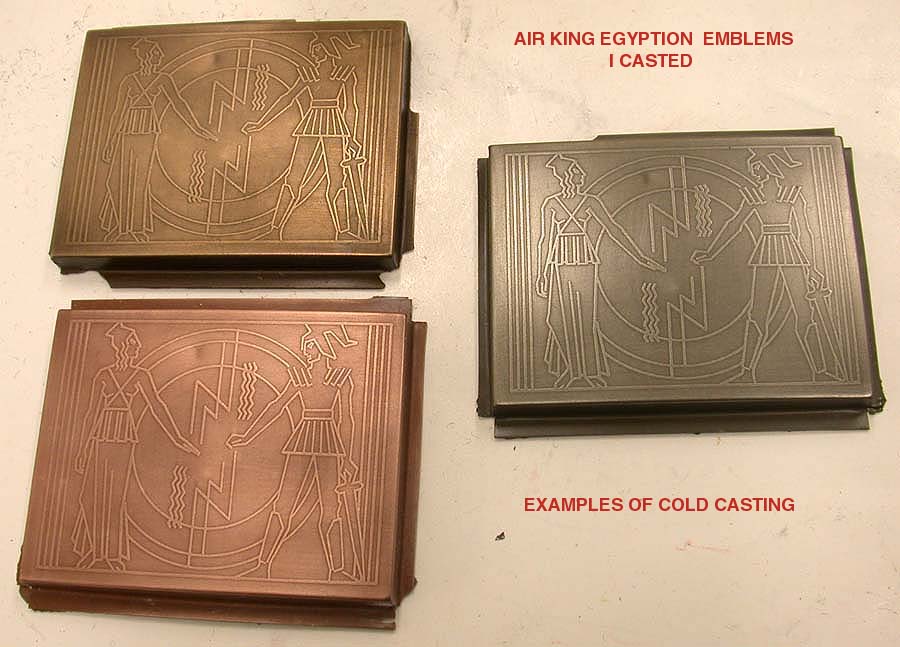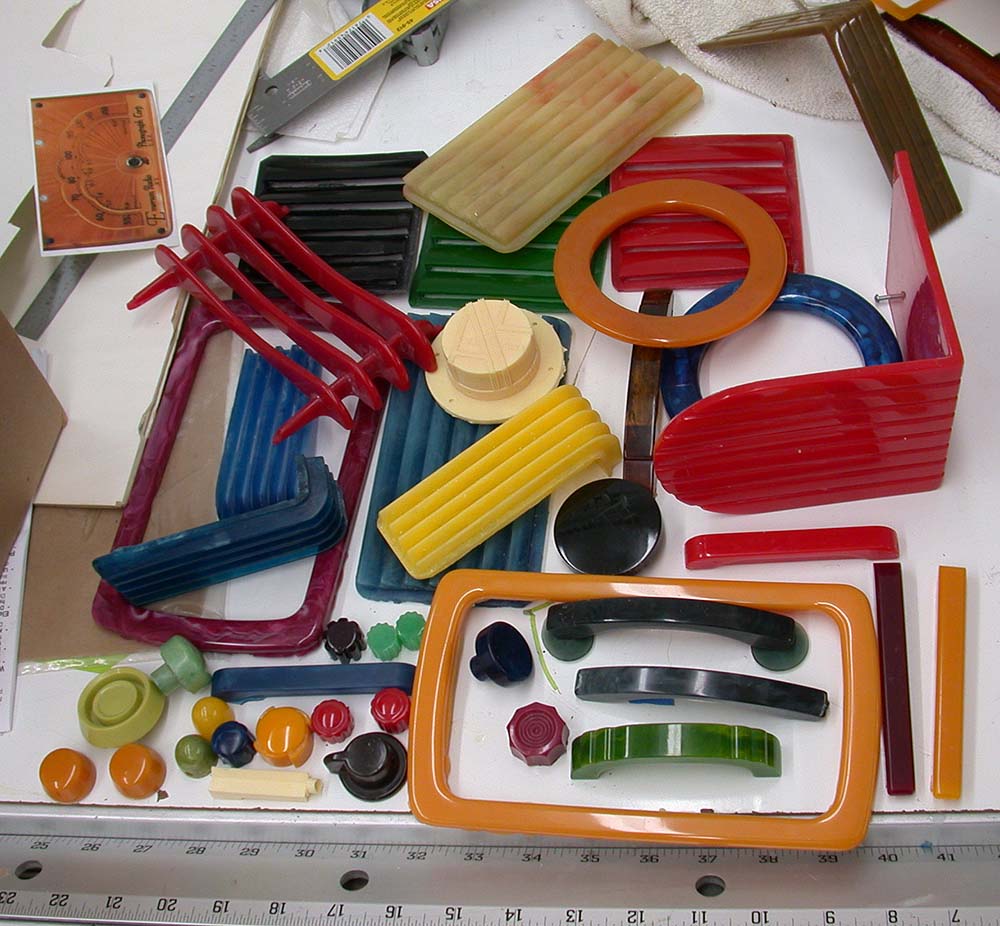 |
New Collection For Sale |
 |
1. Cut/Polish restoration of the catalin to its original color and polishing to a glass finish. Or I can also just put a hand polish on the radio.
2. Repairing cracked catalin radio cases. I developed resin repairs which can be used in repairing chips or missing areas OR I have been trained by Dan Blake to repair catalin radio cases using a technique he developed about 20 years ago. I use the materials and techniques he taught me to do these repairs which have stood the test of time.
3. I make reproduction parts cast from resin. I also can use a technique called cold casting to make parts that look like metal.
4. Straightening warped catalin.
5. Some radio electronic repair. I can repair the electronics to get your radio chassis playing in most cases.
6. I also buy and sell catalin radios and clocks.
7. Another service I offer is to evaluate the condition a radio collection or possibly a radio you are looking at to buy or sell. It's better to know before you spend thousands of dollars if you are buying an authentic original radio or if your radio has been repaired or altered in any way. In past evaluations I have found colored grills and trim pieces that have been cut from old stock catalin and machined to look like original parts. Colored Fada 5F60 and Fada L-56 grills are examples of what I have found to have been counterfeited. Theses parts were expertly machined and look great but that does not change the fact that they are not valued the same as an original part. Don't get me wrong, I don't have a problem with parts being made, though I do have a problem with people selling them as originals to unsuspecting buyers with no knowledge of what they are buying. I have found also a black Motorola S-Grill case that was made of resin. I can identify these counterfeit parts before you make a very costly mistake.
 |
New Collection For Sale |
 |
9. Check out the Worlds First Fender Catalincaster GuitarFor Catalincaster Pictures Click Here!!! |
 |
Check out my current Ebay auctions:
First I would like to cover some points about catalin. Catalin changed color on the surface due to UV light causing a chemical breakdown that produced drastic color changes not only on the surface but into the surface about 1/64". Butterscotch almost always started out as white or alabaster white (marbled). Blue would turn dark green to almost a black sometimes, red would darken a bit though the white swirls would yellow causing the radio to take an orange tint. Green would take a brownish tint. When catalin cracks, the internal surface area of the crack turns color over time. This usually makes cracks appear as a dark line.
I have been asked by many collectors to help with the knowledge needed to evaluate the condition of catalin radios so I am going give the main points that I use in determining value. I sincerely hope this is helpful so that new and old collectors can get a better understanding about catalin. But first some history.
" There are no good buddies when it comes to these radios." That is a statement that a friend told me when I first got into collecting radios and as time passed I have found this to be a very accurate observation. The high values can bring out the worst in people. The best thing a buyer can arm himself or herself with is knowledge.
The value of catalin radios has been a sore subject. Old time radio collectors are usually a little pissed that the prices have gone crazy. They are actually mad that most of them had opportunities to buy but passed on radios that could have been bought for peanuts. The funny thing is that 20 years ago most of these guys in radio clubs across America ignored catalin radios calling them stupid plastic radios while collecting mostly wood sets. When the John Sideli book "Classic Plastic Radios" came out in 1990 the world of art deco collectors became aware of these beautiful radios and they started to compete for the radios. The prices started to go up and has gone up ever since. Every collector should own this book though there were a few radios left out. The Symphony split grill, The Detrola split grill, The Namco also put out as Bestone, and The Maguire and The Universal or Gillette. I own a prototype Stromberg Carlson that was never produced or published in any book.
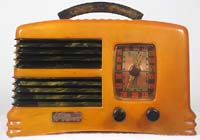
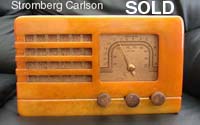
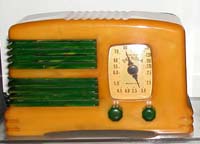
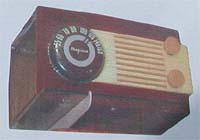
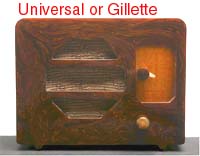
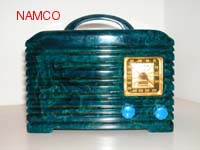
When Ebay hit in the mid 1990's, pickers, antique dealers, and junkers across America saw what prices the catalins were fetching at auction. We then witnessed all of the radios that these people had been hoarding for years finally have an outlet to sell them and get the visibility of a world wide market. It was not unusual to see 20 radios a week on ebay. This went on for years and when 911 happened, the amount started to taper off. Now we are lucky to see a few radios for auction in a month.
What is my radio worth or how much should I pay??
There is no book that can be bought that accurately gives values. Most books are way off, usually low by a lot. And to make matters worse, the subtle differences like color or the amount of swirling and transparency in the different models can make huge differences in value. You can try to research what specific radios have sold for in the past but that can be hard to do. Recently at auction some radios from the Mark Woolley collection set some new records at Bonhams auction in New York Dec. 2007. Though as in most antique collectibles, an item is worth what someone is willing to pay.
There are a number of things one should know if your going to collect catalin radios.
Always buy perfect examples when possible.
This is a lot easier said than done. Catalin was not a very stable material and would shrink which causes internal stresses and sometimes stress cracks. All catalin shrinks to different degrees but if a radio was kept in a good environment there is a good chance of having survived in good shape. This is one of the realities of the material. When a perfect example is found, it will usually get top market dollar for its particular make, model, and color. Yes a radio can be repaired which I will cover later.
Is there something that can be done to help relieve the internal stresses caused by shrinkage that might be present in a radio case??
Yes, though it is not agreed on by everyone. By simply and slowly warming the whole case up and letting it cool the molecules will relax and realign. Some people have set them in the sun and others will put a hole in a box ant heat the radio in the box with hot hair from a hair dryer.
How do I get my chassis out when it is stuck??
Do not try to muscle it out. This is how allot of these get broken. Always use heat as described above or you can try the following method. The most common stuck chassis is the Sentinel Wavy grill The catalin shrinks so much that it seems impossible to get the chassis out. Here is what I do. Remove the knobs. Heat your oven up to 200-300 degrees or so for 20 minutes so the oven walls are heated. Then turn it off!!!!!! Place the radio in the oven and let the whole thing heat up from the hot air in the oven.This takes about 10 minutes. The catalin case must become very warm in order for the catalin to relax enough to get the chassis out. Catalin can take allot of heat. It won't melt like the newer plastics but it will burn from too much heat. Once it is very warm,(almost too hot to touch) place on a surface and take a small hammer and a long screw driver. Tap on the chassis accessed through the knob holes making sure you tap at the outside part of the whole so that you don't put the screw driver on the dial string, going from volume hole to tuning hole with a screw driver tapping gently on the metal chassis. Catalin relaxes when hot and you should be able to get it out. Take your time with light taps. Once it is out you can shave the chassis to get it back in.
What about straightening a warp?
Yes a warp can be straightened by heating the case to the point where it becomes pliable. Then it must be held in the straightened position until cool. A lot of warping is caused by the case shrinking. Even though you can straighten it using the heat, it has been my experience that the case might not stay exactly where you leave it. The warp can seem to have varying amounts of memory. Catalin does not melt!! It will become somewhat pliable at certain temperatures but if it gets to hot it will burn… Game Over!!
Are there any cracks?
Old cracks usually show up as a dark line. But new ones can be harder to see. A crack on a radio can cut the value by half. Where the crack is makes a difference. If there is an inner crack that does not appear to have traveled to the outside surface the value might go down 10% to 20%. It can be very difficult to detect a stress crack in blue catalin. That is because the outer surface has become very dark green to almost black. It might be necessary to use a jewelers loop or magnifying glass in
conjunction with bright light. In most brightly color catalin it is easily spotted. You should inspect every inch of the radio. If the radio has been bumped it can show car window spider cracks.
Are there any chips?
Just feel all the edges with your hands. It is quite common to find chips on the holes that hold on the cardboard backs. Chips can also lower the value.
Are the trim and knobs original? Knobs, grills, and handles
Original parts are always a plus. I make most Resin replacement parts that are available if needed and there is someone I know machining real catalin parts from old stock catalin. This is a preferable replacement part if the color matches. Non original parts greatly affect the values.
Is there any tube burn or heat discoloration?
You should always inspect the inside of the radio case and hold it up against a strong light source. Any sign of damage on the inside will definitely show on the outside of the case if you ever cut/polish the case to the original color.
Is there any sign of small surface crazing known as catalin cancer?
This is a condition that can develop if a radio has been in a bad environment or I have seen it happen from chemicals. Sometimes it can be sanded out but in most cases there is nothing that can be done. Stay Away!!! Whenever you buy a Fada bullet you should inspect around the dial bezel for stress lines because they were held in with a glue that would cause stress lines or catalin cancer under the lip / edge of the bezel.
Has the radio sustained UV damage (ultra violet light)?? This is hard to detect with 60 years of patina and color change, you should defer to an expert. The lighter pastel colors are very susceptible to fading like a pink Tom Thumb or a turquoise Motorola circle grill which almost always show fading.
What about hand polishing and patina? There is nothing wrong with polishing radios using a rag or wheel and a compound though this can be a bit tricky to keep the color nice and even. The more you polish, the lighter the radio becomes. You have probably noticed there are a lot of shades of yellow to butterscotch radios. They are almost always alabaster white when made but because of the surface patina color change that happens to catalin, they all look a little different. This is like looking at something through a yellow colored gel frame. Sometimes you cannot tell what color something is until it is sanded. There are radios that should be left alone like the rare ones.
What about cut / polishing or restoring a radio to its original color?
All catalin changes color on the surface and the only way to get the true color is to cut /polish the surface. Though a lot of the patina will wash off with strong detergent and show more color, the only way to get through to the original color is to sand the surface with wet sand paper It is recommended by many purists that you stop with a detergent cleaning and hand polish the radio. Cut polishing is sanding through the surface discoloration to get to the original color. The amount of material removed varies from color to color. It is a complicated process and should be left to the pro’s. As to whether you should do your radio, ? That is up to you. It can affect the value sometimes and if you are not sure, ask an expert.
Will the radio turn color again?
Yes, the radio will always change! Nothing stops the color change… If you keep it out of direct sunlight it might slow the process down. Some collectors use a marine grade high UV protection wax Different colors will change at different rates. The fastest changing color is the pure white Emerson Patriots that will change back to orange in 3 years. It seems that the more white pigment that was part of the original color, the more the change is noticed. Darker colors can take years longer to become noticeable.
Does the radio need to play?
This is totally up to the collector. It is nice to have a functional radio though there is a danger of tube heat causing damage to the case.
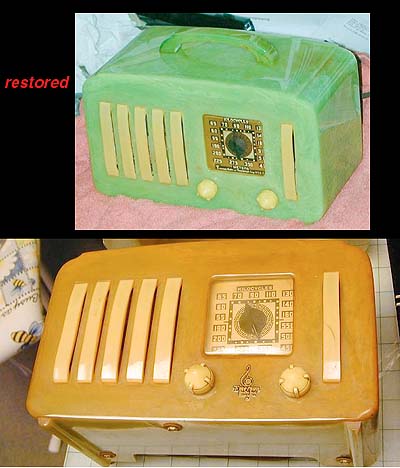
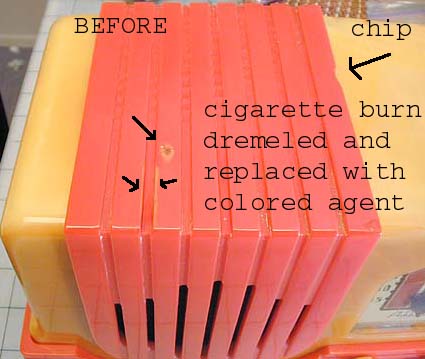
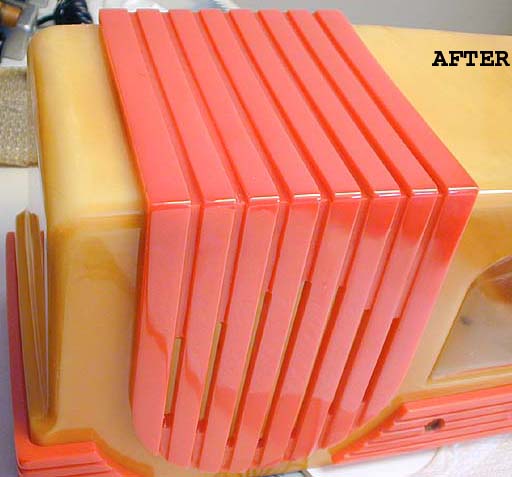
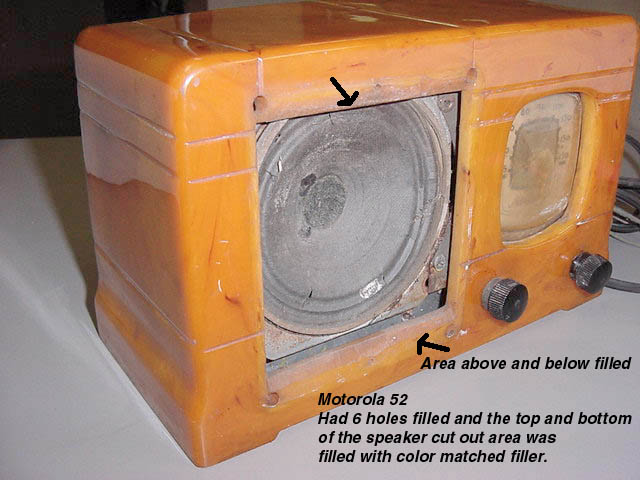
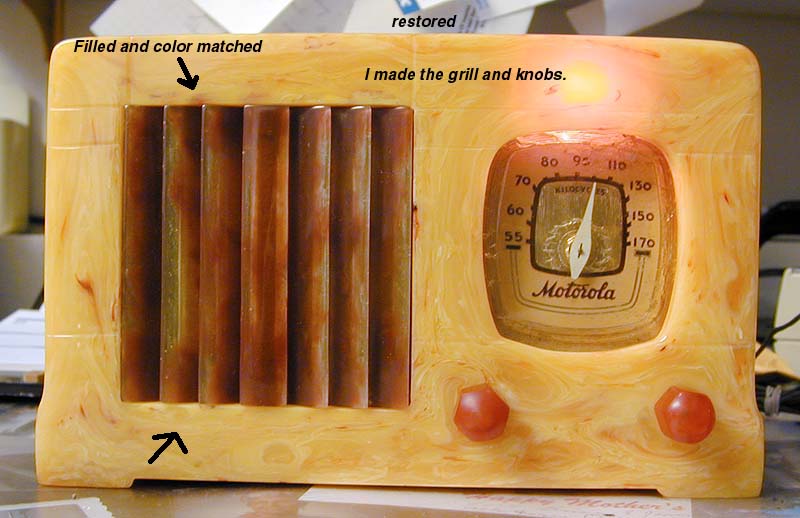
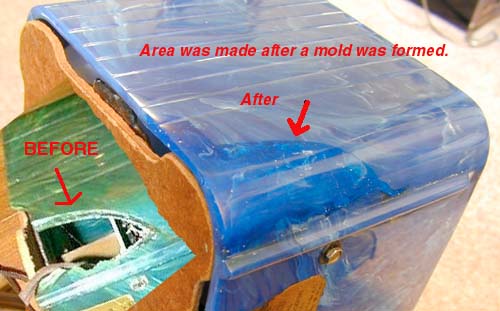
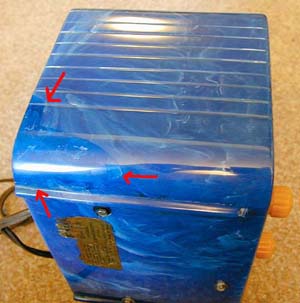
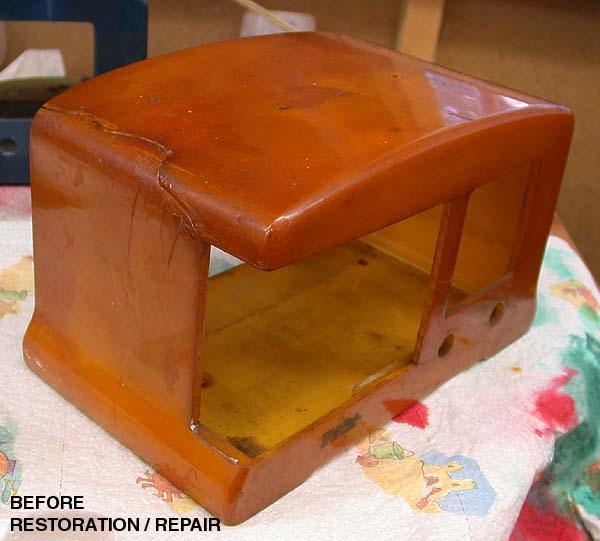
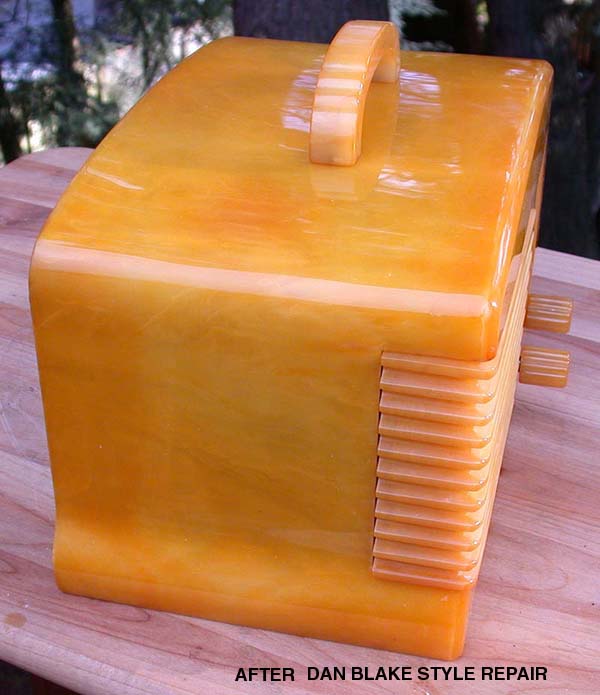
I currently make molds for almost all parts for catalin radios. If your in need of something special drop me an email.
